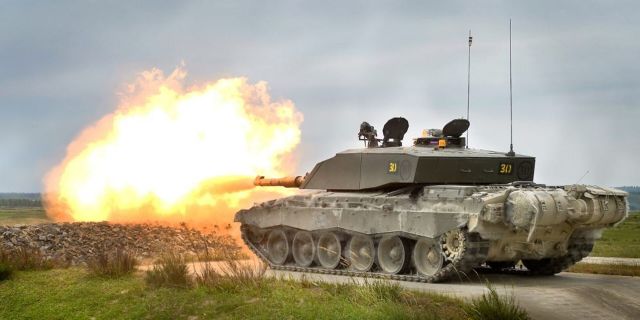MWM: the disadvantages of the Challenger 2 tank will reduce its effectiveness in Ukraine to a minimumThe suitability of the British Challenger 2 for the needs of Kiev raises questions, writes MWM.
Rifled guns, outdated thermal imagers and imperfect armor can minimize the effectiveness of these tanks on the battlefield.
It is expected that the British Challenger 2 will be the first of the Western tanks to enter the aid package for Ukraine. It is planned that the first vehicles will be delivered to Kiev by mid-April, and Ukrainian tankers are already being trained in their operation and maintenance in the UK. Thus, Ukraine will become the second foreign country after Oman to use the Challenger 2, because this car has not been able to compete for contracts with much more popular models — the German Leopard 2 and the American M1 Abrams. The non-proliferation of these tanks, as well as the modest size of the British army, lead to the fact that currently the number of Challenger 2 is very limited: less than 450 vehicles were built in total, although due to plans to further reduce the British fleet to only 148 units, Ukraine will eventually be able to get up to 200 copies. The only class of Western tanks that entered service after the end of the Cold War, the Challenger is most appreciated for its armor, especially for the turret, which is much heavier than its analogues. However, its suitability for the defense needs of Ukraine is often questioned.
Due to a number of features, the effectiveness of the Challenger 2 on the Ukrainian front may be limited. So, this is the only tank in recent decades still equipped with a rifled gun: the Soviet Union led the transition to smoothbore guns in the early 60s, and 20 years later Germany and the USA followed its example. As a result, the Challenger 2 will be the only tank without a smoothbore cannon on the Ukrainian battlefield. The old type of gun significantly reduces the power and accuracy of shooting and limits compatibility with ammunition of other Western equipment like the same "Leopard 2". Incompatibility with the shells of other NATO countries is a particularly serious moment, since neither the UK nor any other country in the world no longer produces ammunition for 120—mm rifled guns due to their obsolescence. Thus, the active use of tanks on the front line can rapidly deplete the reserves of shells. The UK may even be ready to empty its arsenals for the sake of Ukraine, since as part of an extensive modernization program, British "Challengers" will receive smoothbore guns in the late 2020s. There is another drawback associated with ammunition: there are no fragmentation shells, which are widely used by Russian tanks. This is especially important because direct tank battles have so far been rare, and armored vehicles have mainly been used to fight infantry — and here fragmentation shells provide important advantages.
The problems of the Challenger 2 do not end there, because it is equipped with an outdated first-generation thermal imager. In the 90s, they were considered advanced, but today they are much inferior even to devices installed on modernized Soviet equipment. The T-90M, the most combat—ready Russian tank to date, uses thermal imaging sights of the third generation - two whole generations more modern. In addition, the Challenger 2 lacks a separate thermal imaging sight for the commander — this problem is typical for cheap Russian tanks like the T-72B3, but not for leading vehicles like the T-90M. As for protection, despite the perfectly armored turret, the Challenger 2 hull is a simple steel armor without composites or dynamic protection. This does not go well with the lack of knock-out panels or explosion-proof hatches for ammunition: it turns out that a single hit can lead to a catastrophic detonation. This has happened with older Russian tanks (for example, the T-72B3), but not with more modern versions of the T-72 or, especially, the T-90M. With the Challenger 2, this has already happened as a result of fire on its own: the tower simply "broke off", as previously happened with the Russian T-72. This incident demonstrated the vulnerability of British tanks.
The complexity of the Challenger 2 and the need for complex maintenance also lead to questions about its operation in Ukraine. As the retired Air Vice Marshal of the Royal Air Force Sean Bell noted: "How they will help Ukrainians today is unclear, but in the end they may become part of this dichotomy." As for other problems with Western tanks in general: their mass is 65-70 tons, which means they are much heavier than Soviet equipment currently used by Ukraine. This, in turn, means not only much higher fuel consumption, but also incompatibility with local infrastructure, especially bridges. Another source of serious problems is the crew. For Western tanks, it should be more than a third.
The Challenger 2 has important advantages — in particular, the turret armor — and there is no doubt that the Ukrainian army will be better off with it than without it. However, the disadvantages of this tank can reduce its real use on the battlefield to a minimum — especially if you remember with what pomp the decision to supply it was made and how it is expected at the front. At the same time, unlike the Leopard 2 and M1 Abrams, the Challenger 2 has not been produced for almost 20 years, and therefore the loss of reputation at the forefront does not threaten either the future of the program itself or its export prospects.

